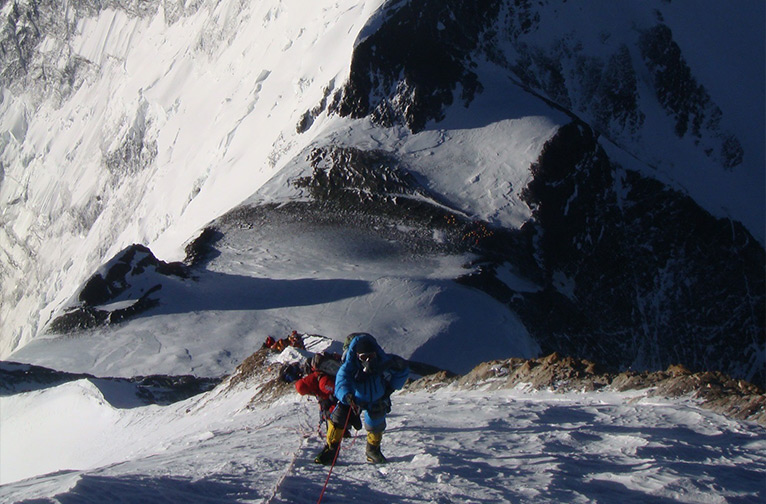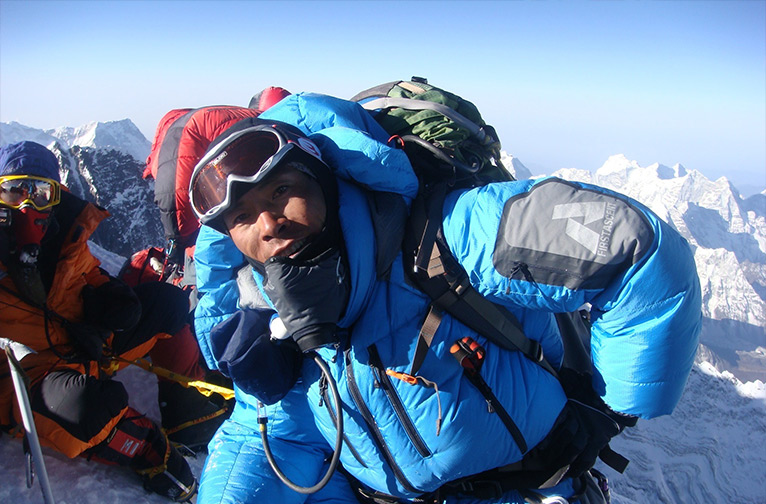You can climb the world’s highest mountain, you can trek iconic Himalayan trails, and you can wildlife watch in pristine forests. Yes! Nepal is one of the world’s top adventure playgrounds. That’s not all. You can also dig deep into centuries-old traditions and local culture and spend time with its ethnic peoples learning all about their worldview.
For the love of Everest
The fantastic Sagarmatha National Park is home to the world’s highest mountains, searing the skyline in attendance with the legendary Mt. Everest. It’s a dizzy experience of rare delight to enjoy a champagne breakfast in plain sight of this dangerous peak, which has for decades beckoned climbers from all over the globe. The icing on the cake is the thrilling helicopter flypast of the world’s six tallest peaks: Lhotse, Makalu, Cho Oyu and Everest. Instead of flying to Everest Base Camp, you can opt to do the Everest Base Camp Trek. If you have time, try to pack in a few days exploring the fabulous wildlife and botanical wealth of the Sagarmatha Park as well. There’s the promise of sightings of the world’s rarest species, such as the shy snow leopard, red panda, and Himalayan black bear.
Worshipping A Virgin Goddess
Intrinsic to Nepal’s Hindu religious traditions is the reverence accorded to Kumari, the Living Goddess. To discover more about this unique spiritual pursuit, head for Kathmandu’s Durbar Square, a UNESCO World Heritage Site. Located here is the Kumari Ghar, the earthly home of the goddess. The secretive ways of Kumari worship is a rich and unique saga that began in the 17th century. Traditionally the Kumari is a Newari pre-pubescent girl, who is revered as an incarnation of the Goddess Taleju, tutelary deity of the Malla and Shah rulers of Nepal. Mingle with the crowds in the hustle and bustle of the historic Durbar Square and hope you get a glimpse of the goddess, at her window, for her blessings.
Bhaktapur- Window to the past
As tourists mill around the medieval city of Bhakatapur, they will quickly discover how Nepal’s past clasps hands very firmly with its present. Bhakatapur, which lies on the ancient trade route with Tibet, is the third of Nepal’s royal cities; but unlike bustling Kathmandu, is suffused with an air of quietude and allows for a more slow paced exploration of its attractions. Centre stage here too is the historic UNESCO-acclaimed Durbar Square. Once the site of coronations and royal processions, it is famous for its Kumari Ghar, wherein the ‘Living Goddess’ lives out her days, dictated by secret rituals. Unmissable here is the Palace of 55 Windows dating to the time of King Bhupatindra Malla in 1754. Key features are its 55 ornate windows and the Golden Gate, a masterpiece in repousse art.
Trekking Haven
Nepal’s trekking trails are amongst the most alluring in the world. Little wonder Kathmandu, the capital, bustles with a huge international community of not only climbers but trekkers as well. Apart from Everest, the most buzzing trekking areas are the Annapurna, and Langtang regions. While trekking through Shivapuri Nagarjuna National Park near Kathmandu, you get incredible views of the Langtang Himalaya. Trekking routes to Nagarkot, Gosaikunda, Helambu and Langtang National Park also pass through the park. Pokhra is the gateway of the Himalayas for trekkers and the jump-off point to the Jomsom and the Annapurna region. The Annapurna Circuit, for example, takes about 21 days. Not only do these trails open up the splendid natural beauty of Nepal, they are a magical window to the diverse communities and their culture.
Chitwan and the Terai
The richly forested and fertile environs of the Terai region are home to the splendid Chitwan National Park. It’s one of the world’s most favoured hotspots for animal viewings. Expect sightings here of rhinos, Bengal tigers, leopards, sloth bears, gaur, deer, and dolphins and crocodiles. The Chitwan area is also best explored on the Chepang Hill Trek, which passes through a rhododendron forest. It’s a lovely eco-friendly, back- to -nature experience with the bonus of a panoramic sunrise over the Rolwaling, Gauri Shankar, Langtang, Manaslu and the Annapurna range. This trek also brings you in contact with the unique culture of the Chepangs, an indigenous Nepali community. Their isolation has helped preserve and sustain their ancient traditions and customs.
Patan-City of the Arts
Now known as Lalitpur, the centuries-old city of Patan is a repository of some very ancient traditions of art and crafts in Nepal. We can see these traditions reflected in the palaces, pavilions, temples, heritage buildings and historic structures such as the Durbar Squares. From carved statues to thangka paintings, from artworks on sheet metal to images of deities in metal, you name it and its there for you to marvel over. At the historical locality of Oku Bahal, you still find artisans creating statues carved in copper, brass, silver, gold, pancha dhatu and astha dhatu.
Pashupatinath Temple
One of the oldest Hindu kingdoms in the Himalayas, Nepal has been a pilgrim hub for centuries. Located on the outskirts of Kathmandu city, the UNESCO-acclaimed Pashupatinath Temple has been viewed as one of Asia’s most valuable religious sites. It is dedicated to Lord Shiva. Spread along both banks of the Bhagmati River, the temple complex is a massive affair with an array of shrines, monuments, libraries and ashrams. They built the temple in the pagoda style. Of note are the gilded two storied roof and the massive Nandi in gold leaf.
Bouddhanath Stupa
Nepal’s biggest stupa is a UNESCO acclaimed heritage site and part of the Kathmandu Valley array of UNESCO sites. Just 7km from Kathmandu city, it’s also referred to as the Khasti Chaitya, and is amongst the oldest stupas in the country. Of note, here is the painting of the eyes of the Buddha depicted in red, white, and blue. The great square of the Stupa is perpetually busy with monks taking part in their daily rituals. A tour of the stupa in the company of a monk adds a vivid insight into its importance to the Buddhist community. You also get to explore some of the nearby monasteries. The visit is special as you may join the monks during daily chanting and ritually light the lamps for blessings for you and your family.
Lumbini and the Tharu community
A UNESCO World Heritage Site, Lumbini is where the Buddha was born. The pilgrimage site is renowned for the Maya Devi Temple dedicated to Buddha's mother. The ancient stone relief from the 2nd century CE illustrates Buddha's birth. We can approach Lumbini via the route from Pokhara to the Chitwan National Park. The villages around Lumbini are home to the indigenous Tharu people. According to some scholars, they are the descendants of the kingdoms that existed here when Buddha was born. A guided walk takes you through a Tharu Village to the boundary of the Chitwan National Park. In the course of the walk, you will discover many aspects of the community’s culture, history, religion and language.Namche, Gateway to Sherpa Settlements
To be in Kathmandu and not encounter a member of the Sherpa community is not always a hit and miss affair. Sherpas are an intrinsic part of mountain climbing sagas in Nepal. Everest conqueror Tenzing Norgay’s antecedents are rooted in this ethnic community. We know them for being some of the best climbers in the region and serve as porters and guides as well. Having migrated from Eastern Tibet, they arrived in the Solu-Khumbu Valley in search of better prospects. Namche Bazaar, the important base for climbs, is as an important gateway to the Sherpa settlements. An interface with the community reveals the guts to glory narratives of historic climbs and the role they play in these endeavours. Scientific studies show that Sherpas had undergone genetic adaptations after living in high altitudes for thousands of years.


It’s easy to get waylaid by the past when rambling through the Nepal’s beautiful destinations. This serves as another alluring reason to return to the country to dig deeper into its cultural roots and interact with its friendly people.